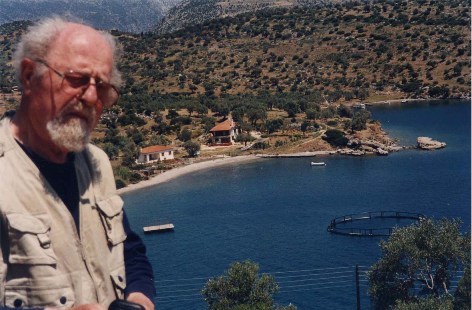
Tel Aviv Museum’s retrospective exhibition of the paintings and sculpture of Robert Baser (1908-1998) is a fine effort to reburnish the memory and reinstate the importance of an artist whose place in the annals of 20th century Israeli art has been virtually wiped out. Undertaking this difficult task, which also involved producing a comprehensive, fully illustrated book-catalog, is the curator of this show, modern art specialist, Prof. Gila Ballas.
Born in Greece, Baser studied at the Athens Academy of Fine Arts, arriving in Palestine illegally at the age of 26. Unlike the many immigrant artists who hailed from Eastern Europe, he was already familiar with the brilliant light and rich colors of the Mediterranean, and was able to start painting immediately.
Baser was among the 15 artists who quitted the Painters and Sculptors Association of Eretz Israel in 1948 to form New Horizons, an avant garde movement eager to create an international artistic language. Looking to Paris, it adopted the language of French abstraction where pure artistic values (valeurs) were of prime significance. The style of painting that emerged locally, lyrical, abstract and amorphous, would dominate the Israeli art scene for the next 20 years. .
In the catalog text to the first New Horizons exhibition, Dr. Haim Gamzu, then director of Tel Aviv Museum, described the aims of this new group as a great adventure “setting sail on the raft of modernism.” Baser, however, only participated in four of the group’s eleven exhibitions, ‘abandoning ship’ in order to live and work in Paris. On this first occasion he didn’t stay long, but later settled in this city for nearly six years before returning home. During this time, his painting was directly influenced by Art Informel, a style that emphasized spontaneity and freedom of form and touch.
This exhibition brings together, in a roughly chronological order, scores of paintings and sculptures produced by Baser over a period of 60 years. From the earliest watercolors of view one can already gauge his preferred subject matter, namely the sea, boats and views of harbors (his hobbies, according to the catalog text were sailing and fishing); and his preferred style which combined abstract, expressionist and structural elements.
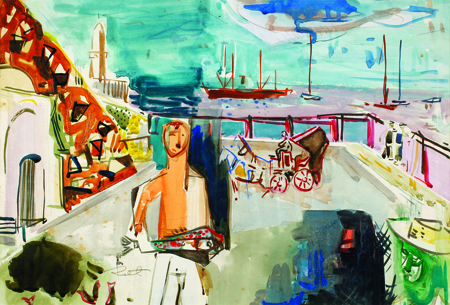
The Fisherman from the 1950s is a delightful example of a painting where objects and figures are clearly visible. Here, the sky, set low on the horizon, meets the sea, conceived in rich tones of blue and pale pink. Folkloristic elements in evidence, like the image of veiled women and a horse and carriage, recall scenes painted by Nahum Gutman in the same decade.
Not be missed are scores of small, beautifully painted watercolors taken from Baser’s sketchbooks, on view in pull-out drawers sited at the center of the gallery space. Complimenting these little gems, is a set of four paintings hung on an adjacent wall. These are delicately brushed abstractions of the port of Paros, one of the Greek islands to which Baser would in later life make an annual retreat.
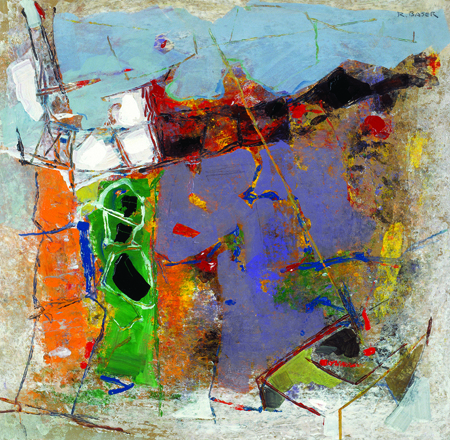
A wide range of larger paintings in acrylic and oils are also on display. Several, inspired by nature are outstanding, among them Landscape from the 1980s, with its glowing color harmonies of mauve, orange and purple, tipped on the horizon with the blueness of sky or sea. But some of the works that Baser produced in his studio (in Jaffa, and later in Sfat) are cumbersome and over contrived, among them interior views where objects and figures are separated by blocks of color or confining lines.
Among the sculptures and wall reliefs on display are those that Baser produced and exhibited in Paris. Extremely varied in character, they illustrate Baser’s ongoing search for a distinctive style. Some pieces are derivative; like his Towers series carved from a block of wood, making reference to Endless Column, Brancusi’s seminal sculpture; and the vertebrae-like piece titled Angel’s Wings which recalls Henry Moore’s sculptures inspired by bones and rocks.
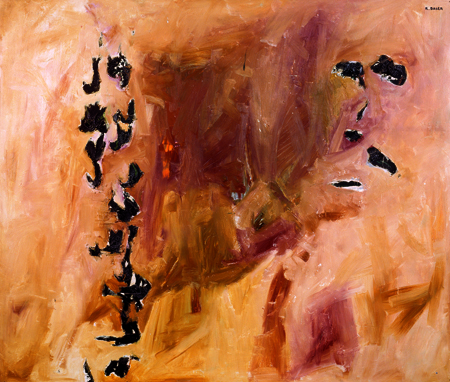
The surprise of this exhibition – for those who previously associated Baser’s name only with tranquil watercolors – was the fact that throughout his career he was concurrently produced both paintings and sculpture reflecting his anti-war sentiments. The earliest painting in this vein, from 1967, is Crows over a Battlefield in Sinai, the title recalling Van Gogh’s turbulent Wheatfield with Crows, produced in the last months of the Dutch artist’s life. In Baser’s painting, one is given a bird’s eye view of a desert terrain, with the birds, represented by thick daubs of black paint, seemingly stuck fast to the land, or else depicted in free fall. In her catalog text, Ballas refers to the possibility that the silhouettes of other images may be buried within the paintwork: a body, a skull, a wolf pouncing on a lamb.
The war in Lebanon is the subject of a series of large oils which Baser executed in 1980s. Each composition is built up from an overlay of color patches and lines, with an occasional ‘real’ image emerging, whether the barrel of a gun, or a crude face rimmed in red.
Anti-war sculptures abound, the earliest being Disassembled Uzi from 1953, comprising parts of a gun fashioned from terracotta, painted white, and glued to a wooden panel. There are also a number of lurid assemblages, among them a wall piece entitled The Unknown Soldier in which the painted (polyester) innards of a man are entwined with parts of weapons. A mirror is attached to the upper surface of this relief. This is a hackneyed device, a way of getting the viewer looking at the work to ostensibly examine his/her own conscience.
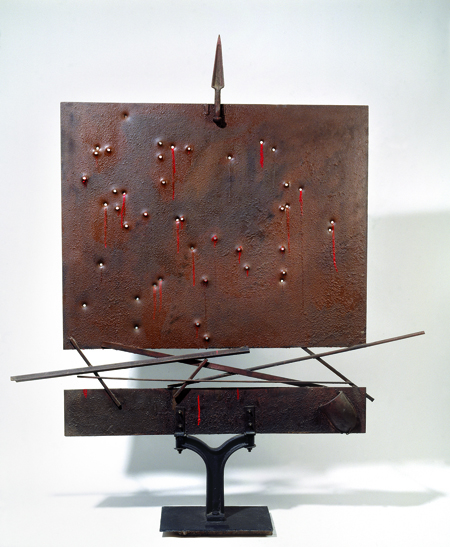
No!, is another theatrical piece. It consists of a rectangular iron plate precariously balanced on metal rods and beams, its surface pitted with holes produced by firing real bullets. Red paint drips from some of these holes simulating blood. At the base of the sculpture is a thin horizontal strip with side pockets holding light bulbs. These were not turned on when this writer viewed this work, but one imagines when lit, a searchlight effect would be produced, with shadows reflected on the wall.
After viewing this show, one is left with the impression that Baser was a courageous artist who was truly ‘sailing’ towards modernism. Setting aside his work in the medium of sculpture, where he was the first in this country (some 10 years before Tumarkin’s militaristic assemblages) to produce art with an anti-war message, Baser deserves a place in the history of Israeli art on account of his watercolors. His skill in this medium has never been surpassed by a local painter.
ANGELA LEVINE






i love to sail at see or on a river, sailing has been my hobby for several years already. ,*’
Comments are closed.